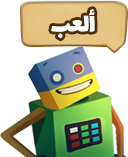يمكن أن يعلم روبوجاردن أي شخص البرمجة. يبدأ بالأوامر الأساسية ويعلم أي شخص مفاهيم البرمجة اللازمة حتى عند الانتهاء من إعداد المتعلم للمساعدة في تلبية الطلب الهائل على المبرمجين في أعمال القرن الواحد والعشرين.

التعلم القائم على القصه .. بإستخدام الرسومات

التعلم القائم على تنفيذ المهام .. التحدي جاهز

دروس تعليمية خطوة بخطوة ... بإستخدام نظام التلميحات
دروسنا لا تشجع على العنف وتشمل الأسس الأخلاقية والتعاليم في جميع رحلاتنا.
نحن واثقون بأن روبوجاردن سيقوم بتدريس البرمجة بكل سهولة وإلا فإننا سنعيد أموالك!
تتم معالجة جميع معاملات الدفع وتأمينها بواسطة Stripe. نحن لا نخزن أي معلومات عن بطاقة الائتمان.
يتوفر فريق الدعم المخصص لدينا على مدار الساعة طوال أيام الأسبوع ونحن على استعداد لمساعدتك في الاستمتاع بتجربة بدون توقف.
يتم تطبيق طريقة روبوجاردن الثورية لتعليم لغات البرمجة من المبتدئين إلى المستوى الاحترافي في 8+ رحلات لتدريس جافاسكريبت وبايثون.
يصبح المتعلم على دراية بمفاهيم البرمجة بالإضافة إلى بنية الجملة الأساسية.
يتعلم الطالب هيكل البرنامج الكامل الخاص بلغة البرمجة ويصبح أكثر دراية ببناء الجمل البرمجية.
يصبح المتعلم جاهزًا للانضمام إلى التطبيقات الاحترافية في البيئة المهنية والبرامج.

Do you want to learn coding in less time than possible and without any money, join us on the best platform ever on learning coding as a game for kids?

